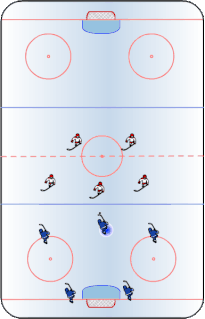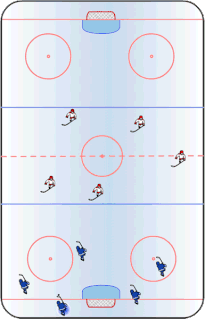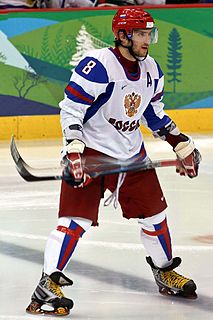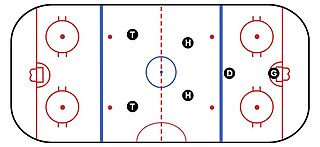 W
WA breakaway is a situation in ice hockey in which a player with the puck has no defending players, except for the goaltender, between himself and the opposing goal, leaving him free to skate in and shoot at will. A breakaway is considered a lapse on the part of the defending team. If a player's progress is illegally impeded by an opposing player or if the goalie throws his stick at the oncoming player, the breakaway player is awarded a penalty shot. If a player faces an empty net and is illegally impeded by an opposing player, he is automatically awarded a goal for his team instead of taking a penalty shot.
 W
WIn ice hockey, butterfly style is a technique of goaltending distinguished by the goaltender guarding the lower part of the net by dropping to the knees to block attempts to score. The butterfly style derives its name from the resemblance of the spread goal pads and hands to a butterfly's wings. The butterfly style is contrasted with stand-up style, where most shots on a goal are stopped with the goaltender on their feet.
 W
WThe centre in ice hockey is a forward position of a player whose primary zone of play is the middle of the ice, away from the sideboards. Centres have more flexibility in their positioning and are expected to cover more ice surface than any other player. Centres are ideally stronger, faster skaters who can back-check quickly from deep in the opposing zone. Generally, centres are expected to be gifted passers more than goal scorers, although there are exceptions, typically larger centres who position themselves directly in front of the net in order to score off rebounds. They are also expected to have exceptional "ice vision", intelligence, and creativity. They also generally are the most defensively-oriented forwards on the ice. Centres usually play as part of a line of players that are substituted frequently to keep fresh and keep the game moving.
 W
WDefence in ice hockey is a player position whose primary responsibility is to prevent the opposing team from scoring. They are often referred to as defencemen, D, D-men or blueliners. They were once called cover-point.
 W
WA deke feint or fake is an ice hockey technique whereby a player draws an opposing player out of position or is used to skate by an opponent while maintaining possession and control of the puck. The term is a Canadianism formed by abbreviating the word decoy.
 W
WIn ice hockey, a grinder is a player better known for his hard work and checking than his scoring. A grinder is often a player who has limited offensive skills, but is valuable to a hockey team due to physical forechecking skills especially along the boards; for "grinding along the boards". The grinder is not in the spotlight as would be the offensively skilled scoring stars, but they are often fan favorites due to their work effort in games. A grinder is often the player who, by their willingness to endure the physical abuse of going into the corners to dig out the puck, often sets up the goals by getting the puck to the team's offensive stars. It is common belief in hockey that a good team needs a balance of scoring stars and grinders.
 W
WThe left wing lock is a defensive ice hockey strategy similar to the neutral zone trap.
 W
WThe neutral zone trap is a defensive strategy used in ice hockey to prevent an opposing team from proceeding through the neutral zone and to force turnovers. The strategy is generally used to level the playing field for teams that are not as offensively talented as their opponents, although the trap can also be used by teams simply looking to protect a lead late in the game. The trap was innovated by the Toronto Maple Leafs in the 1920s and 1930s but became the defensive scheme for most coaches during the late 90s and early 2000s—known as the "Dead Puck era"—as a direct result of the success seen by the New Jersey Devils under the coaching of Jacques Lemaire; the Devils won three Stanley Cup championships during this era. Lemaire utilized the trap that was employed by the Montreal Canadiens under his coach Scotty Bowman.
 W
WA penalty in ice hockey is a punishment for an infringement of the rules. Most penalties are enforced by sending the offending player to a penalty box for a set number of minutes. During the penalty the player may not participate in play. Penalties are called and enforced by the referee, or in some cases, the linesman. The offending team may not replace the player on the ice, leaving them short-handed as opposed to full strength. When the opposing team is said to be on a power play, they will have one more player on the ice than the short-handed team. The short-handed team is said to be "on the penalty kill" until the penalty expires and the penalized player returns to play. While standards vary somewhat between leagues, most leagues recognize several common varieties of penalties, as well as common infractions.
 W
WIn ice hockey, power forward (PWF) is a loosely applied characterization of a forward who is big and strong, equally capable of playing physically or scoring goals and would most likely have high totals in both points and penalties. It is usually used in reference to a forward who is physically large, with the toughness to dig the puck out of the corners, possesses offensive instincts, has mobility, puck-handling skills, may be difficult to knock off the puck or to push away from the front of the goal and willingly engage in fights when he feels it is required. Possessing both physical size and offensive ability, power forwards are also often referred to as the 'complete' hockey player.
 W
WIn ice hockey, a screen is obstruction by a player of the goaltender's view of the puck. The word can also be used as a verb, commonly "don't screen the goaltender", or "the goalie was screened". Screens can be both planned, as when an attacking forward positions himself in front of the net, or accidental, like when a defensemen accidentally blocks the goaltender's view. Attacking players may attempt to take advantage of a screen by taking a shot, which is more difficult for the opposing goaltender to save if he is being screened.
 W
WThe torpedo system is an ice hockey on-ice system first used by the Swedish team Djurgårdens IF. The coach of Djurgårdens IF, Hardy Nilsson, took the system with him and it was used extensively by the Swedish national hockey team in international competition. The system converts the traditional hockey layout of three forwards and two defensemen, into two torpedoes up front, two halfbacks, and one lone defenceman. The torpedoes are responsible for forechecking in the corners when the puck is in the offensive zone, and stay around the neutral zone to be sprung into a scoring position. The halfbacks are all-purpose players that run the offense from the faceoff circles in the offensive zone, and defend against the other team's torpedoes. The libero protects the rear of the ice.
 W
WWinger, in the game of ice hockey, is a forward position of a player whose primary zone of play on the ice is along the outer playing area. They typically work by flanking the centre forward. Originally the name was given to forward players who went up and down the sides of the rink. Nowadays, there are different types of wingers in the game — out-and-out goal scorers, checkers who disrupt the opponents, and forwards who work along the boards and in the corners. Often a winger's precise role on a line depends upon what type of role the other winger plays; usually lines will have one more goal-scoring oriented winger and one winger more focused on playing the boards, checking and passing the puck to others to take shots. They tend to be bigger than centreman and smaller than defenseman.